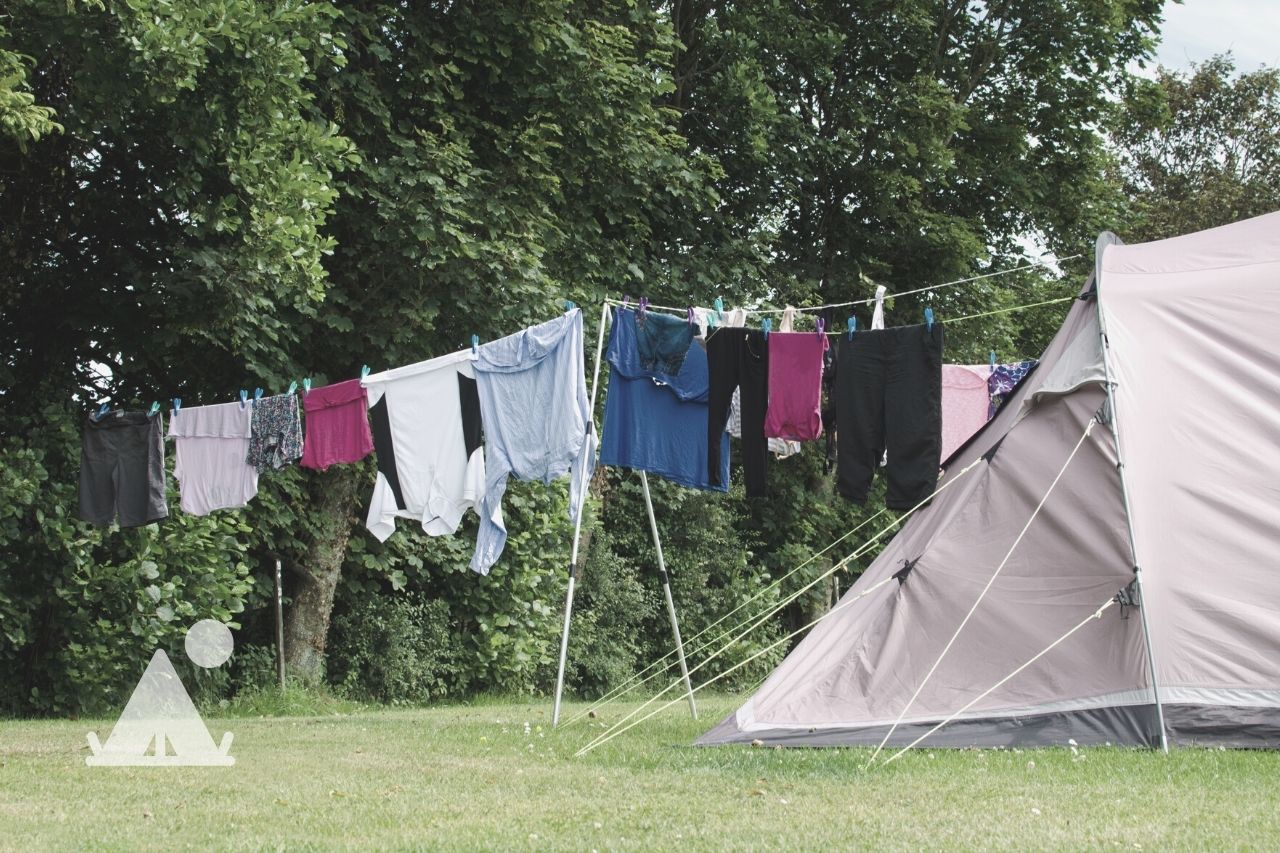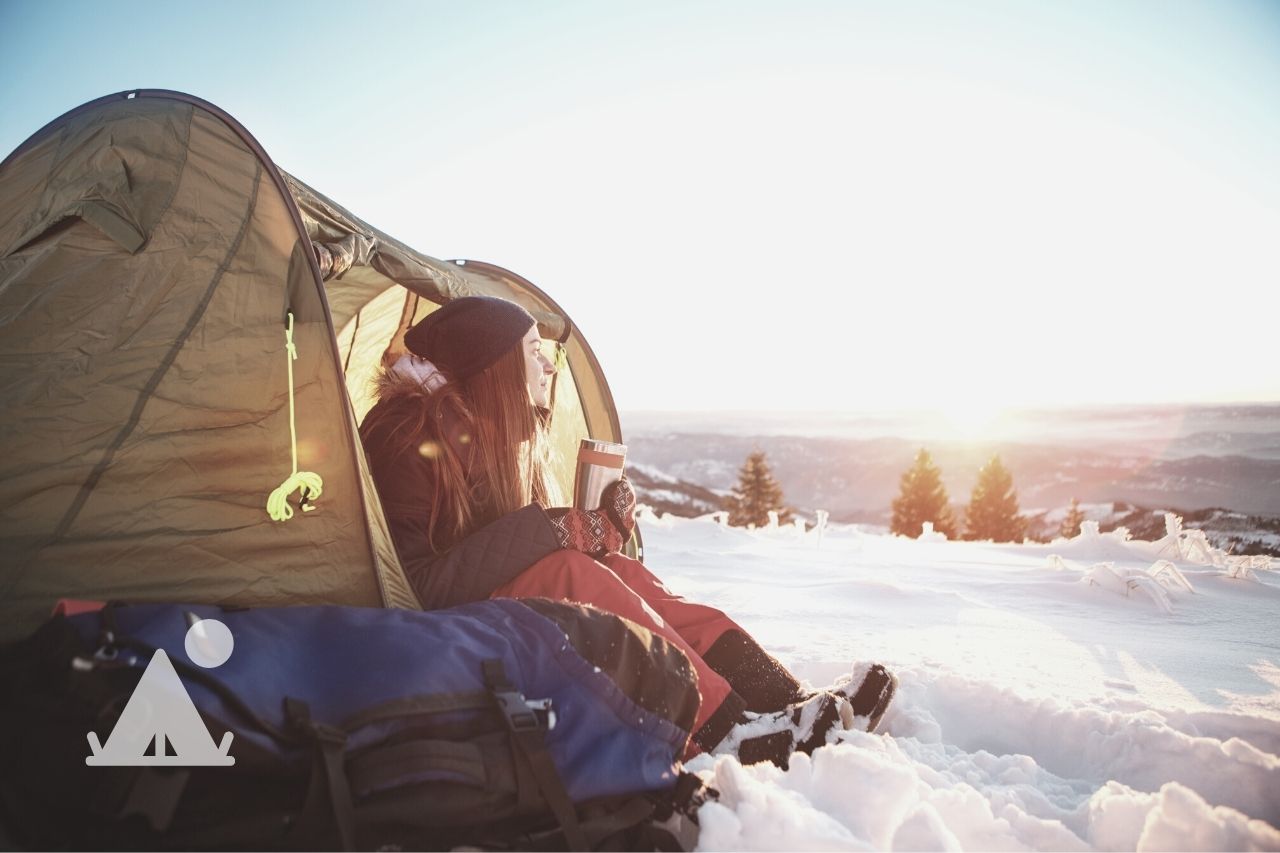Keeping your clothes dry is important when winter camping. Wearing damp and sweaty clothes drains away body heat, leaving you chilled. Here’s how to dry sweaty clothes when winter camping and some tips on how to avoid or reduce sweating in the first place.
5 Ways To Dry Sweaty Clothes When Winter Camping

To dry wet or damp clothes in cold weather, you’ll need good airflow, low humidity, and some heat. You also need to spread the clothes into a large surface area to maximize moisture evaporation.
Based on these principles, here are five ways to dry sweaty clothes when winter camping.
1. Hang Drying Outside
If you have something you can use as a clothesline – any type of chord or rope works great – hang your clothes outside to dry.
Yes, wet clothes can still get dry in winter. Hanging clothes outside is also great for deodorizing the clothes and killing any bacteria on them.
Because you are only drying off sweat, even a little heat from the weak winter sun is enough to get them dry. A bit of wind also helps dry clothes faster.
Don’t worry if the damp clothes freeze before they dry. This can happen in subzero temperatures. Leave them outside and they’ll freeze-dry. This is where the ice on the clothes sublimates directly to water vapor.
Hang drying only works if the weather is dry. If it’s a damp day with lots of humidity in the air, your clothes may not dry at all. Snowy days are also not ideal for hang drying.
Tip: If you have wood or can get some from around, light a fire near where you’ve hung the clothes. The rising heat will reduce humidity and increase temperature, allowing the clothes to dry quickly.
2. Hang Drying Inside The Tent
If the weather is bad outside – too humid, snow, or rain – try hanging the clothes inside the tent. String a rope, chord or twine across the roof of the tent and hang your sweaty clothes from it.
Make sure you have good ventilation inside the tent to dry the clothes quickly and to prevent condensation from building up inside.
If you have a camping heater, turn it on. The extra heat will dry the clothes faster.
3. Spread Out The Clothes
If hanging the clothes is not an option, spreading them out can also work. The exposed surface area allows dampness to escape quickly.
If it’s cold and dry outside, spread the clothes on the side of your tent. If the weather’s not good, lay the clothes on surfaces inside the tent.
You can spread them on a large towel, drape them over your gear, or any clean surface.
As with hang drying, make sure you have good ventilation inside the tent. And if possible, use a heater to speed up drying if you are in a hurry.
4. Put Them In Your Sleeping Bag
This technique is a bit controversial among campers.
Normally, you don’t want too much moisture inside the sleeping bag. It causes the down or synthetic fibers to clump, reducing their insulation and making you colder.
Moisture also ‘steals’ heat from the sleeping bag as it evaporates, again leaving you cold.
But if you are only drying slightly damp clothes or small items like socks, mittens or underwear, you should be okay.
Your body heat is enough to dry the clothes and keep you warm.
Stuff the sweaty clothes inside the sleeping bag when you go to bed. By morning, they should be dry.
Don’t try this method if your clothes are very wet or dripping wet. It’ll leave you cold and shivering.
5. Use a Hot Water Bottle
- Boil water in a pot until it’s boiling.
- Add the hot water to a bottle. Even a foldable bottle like Nalgene will work.
- Wrap your damp sweaty clothes around the hot water bottle. A plastic bottle works best because it releases heat slowly, giving the clothes time to dry.
- Alternatively, use a stainless steel water bottle.
- Add hot water to the bottle then use it like a clothes iron to dry the clothes. Rub or roll it over the damp areas until they are dry.
How To Dry Wet Clothes When Winter Camping?
Usually, sweat makes clothes just a little damp. It’s easy and quick to get them dry.
However, if your clothes are dripping wet (from a rainstorm, a dunk in the river, or laundry), it’s going to be harder to dry them in the winter weather.
Use the same techniques we’ve outlined above (except the sleeping bag one – that’s only ideal for slightly damp clothes), but expect the clothes to take much longer to dry.
If the clothes are dripping wet, first wring them in a towel or anything absorbent to get as much water out as possible.
How To Avoid Getting Sweaty When Winter Camping?

Getting sweaty when winter camping is not only uncomfortable, it can also make you cold, especially once you stop moving.
The evaporating sweat uses up body heat. If there’s a cold wind blowing, you’ll feel even colder.
Finding a way to avoid getting sweaty saves you the hassle of drying your clothes and keeps you warm.
Here are the best ways to avoid, or at least reduce sweat whether you are backpacking, hiking, or just spending time around camp.
Start Cold
If you are going to be active – hiking, cutting wood, or some other activity – your body will generate a lot of heat.
Many winter campers make the mistake of starting comfortable. They wrap themselves in multiple layers of clothes until they feel warm.
The problem is, once they get active, warm becomes hot and the body begins to sweat.
You may not feel the chill immediately. Once you slow down or take a seat, you start losing more heat than the body can generate.
You’ll start shivering while clad in thick layers of clothing.
Be concervative in your layering and don’t worry if you initially feel cold. Once you are moving about, you’ll get warm without sweating.
If you still feel cold after being active for a while, add one layer of clothing.
Shed Layers
If you’d rather be warm and comfortable right from the beginning, you have to be ready to shed the extra layers once you start getting too warm.
As soon as you feel the sweat starting to pool on your skin, remove a layer or two of clothing to stop the sweating.
By then, you’ll have generated enough warmth to be comfortable with fewer layers on.
Be Smart With Your Layering
Proper layering is everything when it comes to winter camping. It keeps you warm, allows any sweat to evaporate, and protects you from the elements.
The video below provides a good summary of a 3-layer system that includes the base layer, mid-layers, and the outer layer.
It’s very important that you choose a moisture-wicking base layer. Fabrics made from polyester and Merino wool work best for absorbing moisture from the skin and transporting it to the outer layers.
The other two layers should be breathable, allowing sweat to evaporate in the air. Otherwise, sweat will be trapped in the base layer, making it damp and making you cold.
Slow Down
If you are hiking or backpacking, it’s better to go slow and steady. This keeps your body temperature from getting too high and causing sweat.
Slow and steady also saves energy and you might actually cover a longer distance.
Another advantage of taking it slow is that you can keep going forever without having to stop. Stopping for a rest will make you cold.
However, some people have more fun moving fast. If that’s you, shed as many layers as possible when on the move. You might find just the base layer to be warm enough.
This lets you walk fast without sweating. And then when you start to slow down or want to rest, put on more layers to conserve warmth.
Ventilate
Increasing airflow to your skin will reduce how much you sweat.
Before you completely remove the outer layers to cool down, try ventilating instead. Open up zips and turn down the collar to improve ventilation.
Some jackets also come with vents that you can open up when you get hot.
If you are still hot and sweaty, you can then take off the jacket.
Switch to Earmuffs To Keep Your Head Cool
One trick to cool down and reduce when you are active is replacing your beanie or hat with earmuffs.
Exposing most of your head allows some of the body heat to escape. The earmuffs protect your sensitive years from the cold and wind.
You can also wear a scarf or gaiter to protect your neck.
How To Deodorize Sweaty Clothes When Winter Camping
You may have successfully dried your sweaty clothes, but they still stink of sweat.
This is a problem if you plan to wear those clothes again. They can also funk up your tent.
The most effective way to deodorize sweaty clothes when camping is airing them outside. The sunshine, even if it’s weak, kills odor-causing bacteria on the fabric, which gets rid of the sweaty smell.
It’s also important to dry your sweaty clothes as soon as possible. The longer they stay wet, the smellier they’ll get.
Even if you don’t plan to wear the sweaty clothes again, dry them before stuffing them in a drybag or backpack. Of course, if you have a chance to wash them, you can do it too!